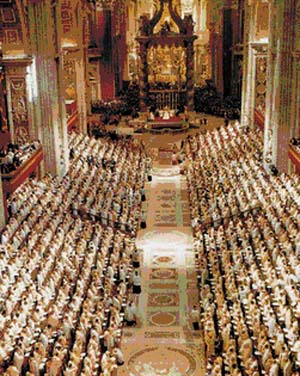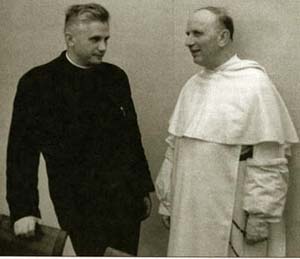 |
Consequences of Vatican II
Vatican II Broke with the Magisterium
Juan Valdivieso, Chile
We are constantly being told that Vatican Council II followed the same lines as previous councils and that the only difference was that it had a more pastoral character. The same people tell us that this Council should be interpreted within the continuity of the Magisterium. In reality, the latter is not possible, because those who tell us to interpret it within this “continuity” end by accepting all the errors and deviations that surged from that same Council, accepted with tranquility by the whole world. It is, in fact, impossible to do simply because no such continuity exists.

Vatican II broke the continuity of the Church Magisterium |
Among the purposes of this blog is to denounce such ruses, and this is the greatest of them all - the most barefaced religious fraud that could be imagined. It is with great sorrow of soul that I say this. What is clear to me is that to remain faithful to the Catholic Faith, we should resist and not remain as passive observers in face of this true passion that the Church is suffering.
We will not attempt to make a doctrinal analysis of the Council here, since the topic is too extensive. We will only cite below some important ecclesiastic personages who confirm that Vatican II broke with tradition.
The well-known progressivist theologian Hans Kûng affirms: “Compared to the Tridentine epoch of the Counter-Reformation, Vatican Council II - in its fundamental characteristics - represents a 180 degree turn. A new Church was born after Vatican Council II.”
And another famous contemporary theologian, Yves Congar, one of the “brains” of Vatican Council II, admitted that “we cannot deny that this text [the Conciliar Declaration on Religious Liberty] materially says things different from the Syllabus of 1864, including almost the opposite of propositions 15, 77, and 79 of that document.”
In another place Congar says that at Vatican II, “the Church had its peaceful October Revolution,” referring to the well-known “Red October,” when Communism destroyed the Empire of the Czars in Russia.
Cardinal Leo Jozef Suenens, Archbishop of Brussels, affirms that the Council “marks the ends of both the Tridentine epoch and the era of Vatican Council I. It is the French Revolution in the Church.”
Karl Rahner defends that the historical-theological significance of the Council supposes a break with the tradition of the Church so great that it is only comparable to the times of the primitive Church, where, according to him, the Disciples of Christ with their initiatives broke the continuity of the past with the new teachings of Jesus. Rahner affirms: "Today we live for the first time in the epoch of a break as great as that which happened passing from Judeo-Christianity to Pagan-Christianity."
The famous Fr. Marie-Dominique Chenu, who played an important role in writing various conciliar texts, affirms that in the History of the Church, the Council signifies a break in its continuity of almost 1500 years because it put an end to the “Constantine era” of Catholicism. Further he boasts that those very points of his theology that had been condemned by Pope Pius XII became the ones that were promoted in the decade of the ‘60s by the new authorities.

Fr. Ratzinger and Fr. Congar represented Progressivism at Vatican II |
When the present Benedict XVI was Prefect of the Sacred Congregation for the Doctrine of the Faith, he affirmed this about the conciliar Constitution Gaudium et spes and the decrees referring to religious liberty and ecumenism: “They constitute a revision of the Syllabus of Pius IX, a kind of counter-Syllabus.... to the measure that they represent an attempt to officially reconcile the Church with the world as it had become after 1789.”
In this context, Card. Ratzinger continues, “the Church,” especially since Popes Pius IX and St. Pius X, “adopted a unilateral position” toward the modern world. Further, the Council and future events “corrected” an “obsolete relation with the State.”
I believe that it is important to clarify that there is some imprecision in this phrase, since the Church did not adopt what he calls a unilateral position toward the modern world only from the time of Pius IX. Rather, this was a position coherent with revealed truth that was held and maintained sound and without break by all the Popes since the beginning of the French Revolution, up to and including Pius XII.
I could continue with many other quotes, but I think that these are sufficient to effectively demonstrate that Vatican II broke with the traditional Magisterium of the Church and that this Council did not follow the light of the Holy Ghost, since God cannot contradict Himself.
I conclude with a consideration about the famous text of the Third Secret, which the Blessed Virgin revealed at Fatima in 1917 and which, by her express command, should have been released for the world to know no later than 1960. Could the Secret have been a warning about this departure from the tradition of the Church that has caused such great ravages in the Faith as a consequence of this Council? And would this be why it has not been revealed still to this day?

Posted September 18, 2008

Related Topics of Interest
 Card. Ratzinger: Vatican II is a "Counter-Syllabus Card. Ratzinger: Vatican II is a "Counter-Syllabus
 Card. Wojtyla: Vatican II Closed the Constantine Era of the Church Card. Wojtyla: Vatican II Closed the Constantine Era of the Church
 Card. Ratzinger Destroyed the Holy Office Card. Ratzinger Destroyed the Holy Office
 Vatican II was a Reaction Against Monarchy in the Church Vatican II was a Reaction Against Monarchy in the Church
 Ratzinger Under Suspicion of Heresy Ratzinger Under Suspicion of Heresy
 Cardinal Suenens Rejects the Church as a Perfect Society Cardinal Suenens Rejects the Church as a Perfect Society
 Card. Koenig: Vatican II Approved what the Syllabus Condemned Card. Koenig: Vatican II Approved what the Syllabus Condemned
 The Crisis in the Church and the Message of Fatima The Crisis in the Church and the Message of Fatima

Related Works of Interest
|
|
Vatican II | Hot Topics | Home | Books | CDs | Search | Contact Us | Donate

© 2002-
Tradition in Action, Inc. All Rights Reserved
|
 |
|